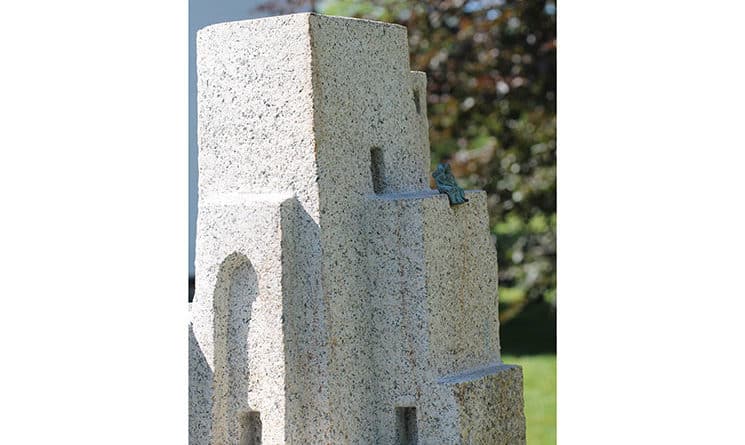Thomas Berger may be the most recognized stone sculptor in the Seacoast. His work has become a part of the landscape at destinations like the Seacoast Science Center, Prescott Park, and Hampton Beach. It is also currently on display in the “Sculpted Places, Historic Spaces” exhibit in both Portsmouth and South Berwick, Maine, at the Barn Gallery in Ogunquit, Maine, and will be in a two-person show with Kate Higley at the Robert Lincoln Levy Gallery during the month of July. His own sculpture garden at Green Art, in Kittery, is open to the public on Saturdays.
He recently took a break to talk to The Sound about the unique qualities of sculpture gardens and working with stone.
What can sculpture do that two-dimensional art can’t?
A sculpture is not just an illusion of an object, it is there, existing in three dimensions and using up space. It can be seen from different angles and offers different views as one walks around it. During the day, the sun moves around a sculpture and puts different highlights on it, and casting shadows that change during the day.
A sculpture can be touched and the smoothness, hardness, and roughness can be felt, even the temperature as it gets warmed up in the sun.
I am especially happy if my sculptures find the interest of children, who in their imagination take a fish in stone for the real thing and hug it, or are hesitant to put their hand into the mouth full of teeth. There is a directness to sculpture that painting does not offer to the same degree.
What’s the unique role of a sculpture garden?
Metal, ceramic, and especially stone are hard, heavy, earthy, solid. They convey the feeling of permanence and stability, while the living creatures around it come and go with the seasons, blossom and wilt, and move in the wind.
Sculptures can fulfill important functions in a garden. Just like a stone wall they can work as an architectural element to which the garden is anchored. Or they can provide a focal point in the distance to which the eye is drawn, thus creating a view axis.
Stone sculpting ought to be the toughest of all arts, but I still love it. — Thomas Berger
Do you design your sculptures to withstand the elements?
I want my sculptures to last for hundreds of years, and I’m sure some of the granite will last a few thousand years and may well outlast civilization altogether. But, on the other hand, I also like it to see some weathering on the stone, because it makes the sculpture look old and timeless.
In fact, instead of protecting my sculptures from the effects of the elements, I often use stones that already show signs of erosion, and if not, I sometimes help it by working them over with a hammer, or cutting fake cracks into the stone. If lichen or moss grow on a sculpture, that is a special honor to the artist, in my view, and makes it part of the organic world.
What do you like about sculpting from stone, versus when you draw or paint?
Sculpting stone is one of the most exhausting and physically demanding processes of creating works of art. While I’m carving, I wear rubber boots and a rubber apron to protect me from the spraying water, ear muffs to cut down the noise of the compressor and tools, goggles to protect my eyes from flying chips, and a dust mask to protect my lungs. And handling large pieces of stone by itself requires special skills and equipment.
Stone sculpting ought to be the toughest of all arts, but I still love it.
First of all, it is a material with infinite variation. Two stones are never the same. The mineral composition changes, there are unexpected veins. I like to use found rock boulders and use their natural shape to advantage.
The oldest artifacts of human creation are chipped stones used as tools, and some of the greatest works of art in the history of mankind are carved in stone. Stone carving is an old tradition, and even though the tools have changed, the results are still made of stone. I like to feel connected to that tradition, and I like the feeling of being connected to the earth as I use a material that comes from the earth.
For more on outdoor sculptures around the Seacoast, click here.
Top of page: Welcome to My Home by Thomas Berger, granite and bronze, at the Governor John Langdon House in Portsmouth.

